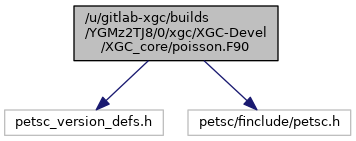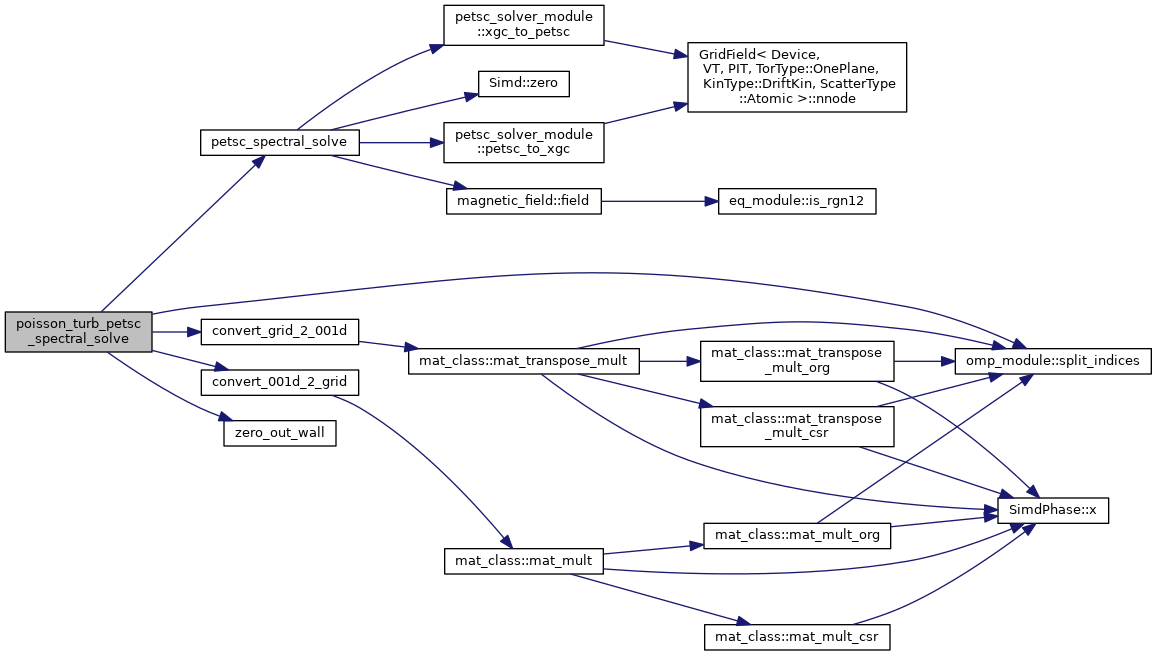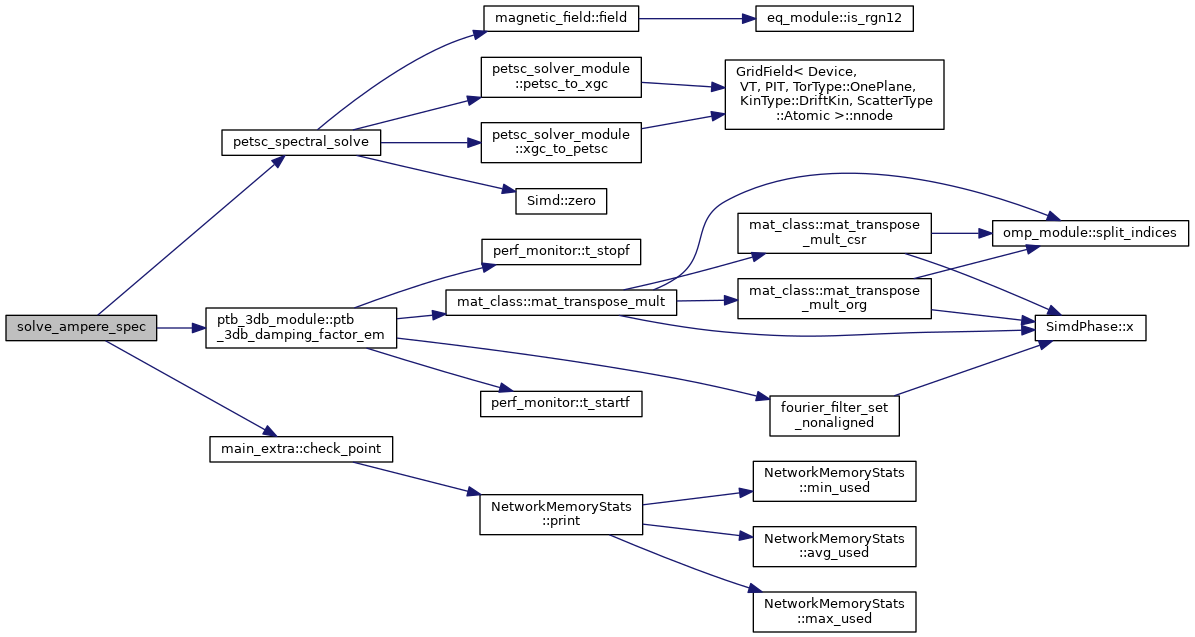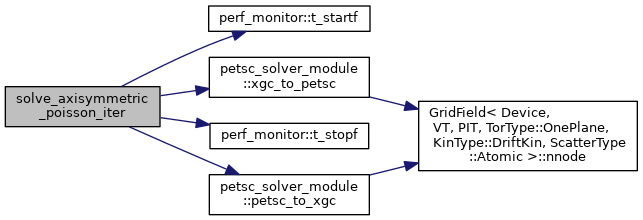|
| subroutine | clear_monitors () |
| |
| subroutine | psn_add_pot0 () |
| |
| subroutine | set_rhs_bd_and_sol_bd (rhs, rhs_bd, sol_bd) |
| |
| integer function | get_ntor_num_from_ntor_real (ntor_real, nphi, wedge_n) |
| | Calculates the numerical toroidal mode number for a given real toroidal mode number. More...
|
| |
| subroutine | set_petsc_rhs_vec_axisymmetric_poisson (xgc_rhs, xgc_rhs_bd, xgc_sol_bd) |
| | Places rhs and (optionally) boundary condition data into a PETSc vector. More...
|
| |
| subroutine | set_to_sheath_pot (tmp00_surf) |
| | Sets initial guess for the iterative axisymmetric poisson solver using the simple00 solver. The initial guess is stored in psnpot0m. More...
|
| |
| subroutine | solve_axisymmetric_poisson_iter (pot0m) |
| | Poisson solver that uses an iterative method to solve for the axisymmetric electrostatic potential: The Poisson equation for the axisymmetric mode is. More...
|
| |
| subroutine | axisym_mat_mult (A, X, Y, ierr) |
| | Subroutine used to apply the shell matrix representing the left hand side of the axisymmetric Poisson equation. More...
|
| |
| subroutine | axisym_ad_mat_mult (A, X, Y, ierr) |
| | Subroutine used to apply the shell matrix representing the adiabatic term in the axisymmetric Poisson equation. More...
|
| |
| subroutine | axisym_pc_apply (pc, X, Y, ierr) |
| | Subroutine used to apply the shell preconditioner used in the iterative solution of the axisymmetric Poisson equation. More...
|
| |
| subroutine | solve_axisymmetric_poisson_two_step_fsa (xgc_rhs, xgc_rhs00, xgc_rhs_bd, xgc_rhs_bd00, xgc_sol_bd, xgc_sol_bd00, pot0m, dpot) |
| | Simple two-step 2D solver driver for the axisymmetric potential and one-step solver ("FSA-solver") with constraint equation for the flux-surface averaged potential. For the two-step solver, the RHS is the flux-surface averaged charge density, the LHS consists only of the polarization operator. The result of the 2D solve is flux-surface averaged; i.e., the result is \(\langle\phi\rangle\) The Poisson equation for the flux-surface averaged mode is. More...
|
| |
| subroutine | positive_phi00_sol (tmp00_surf, pot0m) |
| |
| subroutine | get_xpt_i (i_x1, i_x2) |
| |
| subroutine | add_pot0 (pot0m) |
| |
| subroutine | poisson_turb_petsc_solve (xgc_rhs, xgc_field) |
| | Routine to solve the non-axisymmetric Poisson equation: More...
|
| |
| subroutine | poisson_turb_petsc_spectral_solve (xgc_rhs_spectral, xgc_field_spectral) |
| | Routine to solve the non-axisymmetric Poisson equation: More...
|
| |
| integer(c_int) function | get_solverh_nbndry () |
| |
| integer(c_int) function | get_solver00_nbndry () |
| |
| integer(c_int) function | solver00_use_this_rank_int () |
| |
| integer(c_int) function | solverh_use_this_rank_int () |
| |
| integer(c_int) function | solvera_use_this_rank_int (CV_int) |
| |
| subroutine | solve_ampere_cv (xgc_rhs, xgc_rhs2, Ah) |
| |
| subroutine | solve_ampere_cv_spec (xgc_rhs_spectral, xgc_rhs2_spectral, xgc_field_spectral) |
| |
| subroutine | solve_ampere (xgc_rhs, xgc_rhs2, Ah) |
| |
| subroutine | solve_ampere_spec (xgc_rhs_spectral, xgc_rhs2_spectral, xgc_field_spectral) |
| |
| subroutine solve_axisymmetric_poisson_iter |
( |
real(8), dimension(grid%nnode) |
pot0m | ) |
|
Poisson solver that uses an iterative method to solve for the axisymmetric electrostatic potential: The Poisson equation for the axisymmetric mode is.
\[ -\nabla_\perp \cdot \xi \nabla_\perp \overline{\phi}_{k+1} + \frac{e n_0/T_{e,0}} \overline{\phi}_{k+1} = e \left( \langle \overline{\delta n_i} \rangle_g - \overline{\delta n_{e,NA}} \right) + \frac{e n_0/T_{e,0}} \langle \phi_{k} \rangle_{fs} \]
where \(k\) is the iteration index, \(xi\) is the electric susceptibility, \(e\) is the elementary charge, \(n_0\) and \(T_0\) are the background density and temperature, \(\langle \overline{\delta n_i} \rangle_g\) is the gyroaveraged ion (gyrocenter) charge density, \(\overline{\delta n_{e,NA}}\) is the non-adiabatic electron charge density, and \(\langle\dots\rangle_{fs}\) is the the flux-surface average. \(\overline{\dots}\) is the toroidal average.
The RHS and LHS of the axisymmetric equation can be Fourier-filtered (poloidal modes). The LHS of the non-axisymmetric equation can be Fourier-filtered in the toroidal and poloidal direction. The solver in both cases is a linear finite-element solver on an unstructured triangular grid.
- Parameters
-
| [in] | grid | Solver grid data, type(grid_type) |
| [in,out] | psn | Field data; the potential is stored there, type(psn_type) |
| subroutine solve_axisymmetric_poisson_two_step_fsa |
( |
real (8), dimension(grid%nnode) |
xgc_rhs, |
|
|
real (8), dimension(grid%nnode) |
xgc_rhs00, |
|
|
real (8), dimension(psn%solverh%n_boundary) |
xgc_rhs_bd, |
|
|
real (8), dimension(psn%solver00%n_boundary) |
xgc_rhs_bd00, |
|
|
real (8), dimension(psn%solverh%n_boundary) |
xgc_sol_bd, |
|
|
real (8), dimension(psn%solver00%n_boundary) |
xgc_sol_bd00, |
|
|
real(8), dimension(grid%nnode) |
pot0m, |
|
|
real(8), dimension(grid%nnode) |
dpot |
|
) |
| |
Simple two-step 2D solver driver for the axisymmetric potential and one-step solver ("FSA-solver") with constraint equation for the flux-surface averaged potential. For the two-step solver, the RHS is the flux-surface averaged charge density, the LHS consists only of the polarization operator. The result of the 2D solve is flux-surface averaged; i.e., the result is \(\langle\phi\rangle\) The Poisson equation for the flux-surface averaged mode is.
\[ -\nabla_\perp \cdot \xi \nabla_\perp \overline{\phi} = e \left\langle \left( \langle \overline{\delta n_i} \rangle_g - \overline{\delta n_{e,NA}} \right) \right\rangle_{fs} \]
where \(xi\) is the electric susceptibility, \(e\) is the elementary charge, \(n_0\) is the background density, \(\langle \overline{\delta n_i} \rangle_g\) is the gyroaveraged ion (gyrocenter) charge density, \(\overline{\delta n_{e,NA}}\) is the non-adiabatic electron charge density, and \(\langle\dots\rangle_{fs}\) is the the flux-surface average. \(\overline{\dots}\) is the toroidal average.
NOTE: The two-step solver does not support non-zero Dirichlet boundary conditions!
The FSA solver solves the same equation as the outer-iterative solver (solve_axisymmetric_poisson_iter), but with a twist. The flux-surface averaged potential is treated as an independent field \(\lambda\) in the Poisson equation. In order to make the equation consistent, a second (constraint) equation is added that enforces \(\lambda=\langle\phi\rangle_{fs}\). So the FSA solver solves a 2x2 block system.
- Parameters
-
| [in] | grid | Solver grid data, type(grid_type) |
| [in,out] | psn | Field data; the potential is stored there, type(psn_type) |





















